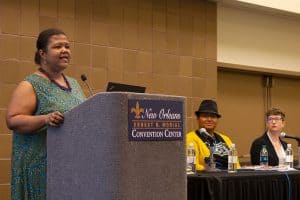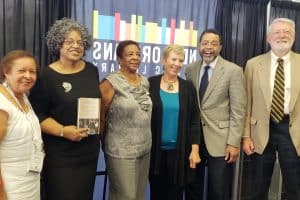
“You can’t talk about issues of race and racism without talking about whiteness and implicit bias,” said April Hathcock, scholarly communication librarian at New York University Libraries, at the opening of “Breaking Below the Surface of Racism, Whiteness, and Implicit Bias,” a program held June 24 at the American Library Association’s 2018 Annual Conference and Exhibition in New Orleans.
After discussing definitions of whiteness (a way of thinking, both intentional and unintentional, that privileges the values of white people over those of non-whites) and implicit bias (the unconscious and conscious stereotypes that we ascribe to others), Hathcock broke the near-capacity crowd into small groups to discuss an example of implicit bias and whiteness in the workplace before sharing their thoughts with everyone. The scenario presented two sides of an incident: one from an American-born woman of Pakistani origin who experiences racism at her workplace to such a degree that she becomes physically ill; the other from her supervisor who discounts her claims without malice, but through ignorance.
The groups all affirmed the woman’s concerns and presented ways that the supervisor could remove an implicit bias that he doesn’t think exists. Hathcock said that this invisible aspect of implicit bias and whiteness is most insidious. “It is rooted in the fabric of our society,” she said. “It is often unintentional, but it has mental and physical effects.
“It goes beyond overt racism,” she continued. “It can be nice, polite, and friendly.” She compared racism and bias to an iceberg—the bulk of it happens hidden and unconscious below the surface. She used a white person asking to touch a black woman’s hair as an example of a hurtful microaggression.
Hathcock gave three ways to combat implicit bias: First, it must be named. Instances of whiteness must be called out for what they are. Second, the underlying assumptions or stereotypes must be identified. Third, people must reframe their thinking and develop alternate ways of acting.
Hathcock also recommended using microaffirmations to counteract microaggressions. When confronted with examples of racism and bias in the workplace by a superior, for example, humanizing the person who is the victim of the aggression can both defuse the situation and provide opportunity for learning.
“This work is difficult work,” Hathcock said. “It can be uncomfortable, but it is important for us to do.”


